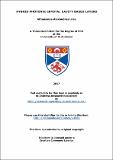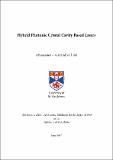Files in this item
Hybrid photonic crystal cavity based lasers
Item metadata
| dc.contributor.advisor | O'Faolain, Liam | |
| dc.contributor.author | Liles, Alexandros Athanasios | |
| dc.coverage.spatial | xii, 150 p. | en_US |
| dc.date.accessioned | 2017-11-14T10:55:35Z | |
| dc.date.available | 2017-11-14T10:55:35Z | |
| dc.date.issued | 2017-12-07 | |
| dc.identifier.uri | https://hdl.handle.net/10023/12081 | |
| dc.description.abstract | In recent years, Silicon Photonics has emerged as a promising technology for cost-effective fabrication of photonic components and integrated circuits, the application of which is recently expanding in technological fields beyond tele- and data-communications, such as sensing and biophotonics. Compact, energy-efficient laser sources with precise wavelength control are crucial for the aforementioned applications. However, practical, efficient, electrically-pumped lasers on Silicon or other group IV elements are still absent, owing to the indirect bandgap of those materials. Consequently, the integration of III-V compounds on Silicon currently appears to be the most viable route to the realization of such lasers. In this thesis, I present and explore the potential of an External Cavity (EC) hybrid III-V/Silicon laser design, comprising a III-V-based Reflective Semiconductor Optical Amplifier (RSOA) and a Silicon reflector chip, based on a two-dimensional Photonic Crystal (PhC) cavity vertically coupled to a low-refractive-index dielectric waveguide. The vertically coupled system functions as a wavelength-selective reflector, determining the lasing wavelength. Based on this architecture mW-level continuous-wave (CW) lasing at room temperature was shown both in a fiber-based long cavity scheme and die-based short cavity scheme, with SMSR of > 25 dB and > 40 dB, respectively. Furthermore, by electrically modulating the refractive index of the PhC cavity in the reflector chip, tuning of the emitted wavelength was achieved in the die-based short cavity EC laser configuration. In this way, I demonstrated the suitability of the examined EC configuration for direct frequency modulation. The proposed scheme eliminates the need for wavelength matching between the laser source and a resonant modulator, and reveals the potential of employing low-power-consumption resonant modulation in practical Silicon Photonics applications. | en_US |
| dc.language.iso | en | en_US |
| dc.publisher | University of St Andrews | |
| dc.rights | Attribution-NonCommercial-ShareAlike 4.0 International | * |
| dc.rights.uri | http://creativecommons.org/licenses/by-nc-sa/4.0/ | * |
| dc.subject | Photonic crystal cavities | en_US |
| dc.subject | Silicon photonics | en_US |
| dc.subject | Hybrid III-V/silicon lasers | en_US |
| dc.subject.lcc | TA1677.L56 | |
| dc.subject.lcsh | Photonic crystals | en |
| dc.subject.lcsh | Silicon--Optical properties | en |
| dc.subject.lcsh | Lasers | en |
| dc.title | Hybrid photonic crystal cavity based lasers | en_US |
| dc.type | Thesis | en_US |
| dc.contributor.sponsor | Engineering and Physical Sciences Research Council (EPSRC) | en_US |
| dc.contributor.sponsor | European Research Council (ERC) | en_US |
| dc.type.qualificationlevel | Doctoral | en_US |
| dc.type.qualificationname | PhD Doctor of Philosophy | en_US |
| dc.publisher.institution | The University of St Andrews | en_US |
The following licence files are associated with this item:
This item appears in the following Collection(s)
Except where otherwise noted within the work, this item's licence for re-use is described as Attribution-NonCommercial-ShareAlike 4.0 International
Items in the St Andrews Research Repository are protected by copyright, with all rights reserved, unless otherwise indicated.



